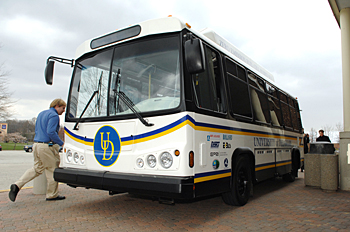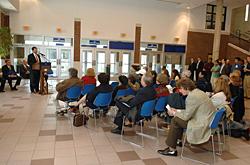The hydrogen fuel cell bus project is supported by a $1.7 million grant from the U.S. Department of Transportation's Federal Transit Administration, matched by private financing from companies working in partnership with the University.
Researchers from the College of Engineering, who are driving the project, said they envision a multidisciplinary demonstration project. Over the course of the project, the team has researched and demonstrated ways to make hydrogen fuel cells more efficient and less expensive to produce and operate, installed fuel cells in a public bus, and will now test the bus as it operates on a regular passenger route around the University's Newark campus.
The project also includes development of a safe and efficient hydrogen refueling station to be used by the bus and, eventually, by other hydrogen-powered vehicles. Another goal of the project is to educate the public and transit officials about the developing technology of hydrogen fuel cells.
U.S. Sen. Thomas R. Carper (D-Del.) said the University of Delaware has made significant contributions to the development of solar energy during the last three decades.
“Our country and our world are at the crossroad,” Carper said during the ceremony. “The decisions that we make in the next 10 years in public policy, in research and development, in lifestyle changes, could determine the fate of our way of life in 50 years, 100 years from now. Today there is still time to make a difference. The University and leaders throughout our state will help to make that difference."
“I am very pleased that our faculty and students have been able to take the lead in bringing fuel cell vehicles to Delaware, and I look forward to future successes as they continue to move ahead,” Eric W. Kaler, Elizabeth Inez Kelley Professor of Chemical Engineering and dean of the College of Engineering, said.
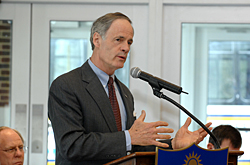
“Most of the major automotive companies are aggressively pursuing fuel cell technology right now,” Prasad said. “When we sought this funding, we were not interested in just buying a fuel cell powered bus and operating it, which already is being done in some places. We wanted to introduce some innovations and inject some cutting-edge research on fuel cells into this project.”
U.S. Rep. Michael Castle (R-Del.) praised Prasad and the research team for their successful efforts: “This group has done a wonderful job of dealing with a very difficult concept--the conversion to something sort of foreign to us in terms of how we run buses and cars in the United States of America--and today we see the real benefit of it, with a real bus that will be able to drive us around the University campus."
Castle also thanked UD President David P. Roselle for his role in promoting innovative research, helping secure major research grants and developing productive partnerships throughout Delaware. "He's been a tremendous inspiration for this University on so many partnerships, and I just can't thank him enough for the exceptional work that he has done," Castle said of Roselle. "You've been a tremendous asset to the state of Delaware and for that we should all be extremely thankful."
A consortium consisting of EBus, Ballard Power Systems, Electric Power Research Institute (EPRI), Air Liquide Advanced Technologies U.S., and the Delaware Transit Corp. has been assembled for this project. EBus is based in Downey, Calif., and has commercially produced more than 100 electric shuttle buses for airports. EBus has adapted its existing 22-foot, 22-passenger chassis and electric drive system to use a 19-kilowatt Mark9 SSL fuel cell stack from Ballard, a major producer of fuel cells located in Vancouver, British Columbia.
EPRI, located in Palo Alto, Calif., has provided expertise and software to model and simulate various sub-systems of the vehicle. Air Liquide, based in Newark, has contributed to the project in two major ways: first, they have provided their climate-controlled, high-bay facility to house the bus, and second, they have installed a hydrogen station next to the high-bay for refueling the bus. The bus has twin high-pressure (5,000 pounds per square inch) tanks in its roof that can store 16 kilograms of hydrogen, with an estimated range of 200 miles.
Initially, the bus will operate on the University campus. The Laird Campus route has been selected for this purpose and the bus will operate as a supplemental vehicle.
Subsequently, UD will collaborate with Delaware Transit Corp. to perform demonstrations to the general public outside of the University. During this period, the researchers said they will be tracking performance, efficiency, control algorithms, emissions levels, operation costs, the frequency of maintenance needed and the ease of repairs.
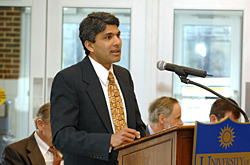
“Companies throughout Delaware are very interested in this project,” Faghri said of the fuel cell bus. “The state has had a few alternative-fuel transportation projects before, but this is by far the largest. And, there's a lot of work to be done, because we're doing this for the first time. We want to move through research and to development to a demonstration project, with commercialization as our eventual goal.”
All three researchers identified three key hurdles to widespread use of hydrogen fuel cells to power vehicles--the cost of the cells, the ability to produce hydrogen in large scale with minimal greenhouse gas emissions, and the ability to refuel as needed.
“My feeling is that hydrogen fuel cells are eventually going to be common in hybrid buses and cars, where they would be combined with electric storage, in the same way that hybrids now combine gasoline and electric power,” Advani said. “The fuel cell technology exists now, but we have to overcome those hurdles. When that happens, maybe in 10 or 15 years, I think you'll see a lot more cars powered by hydrogen.”
Prasad agreed, predicting that the problems of cost and access to hydrogen will be overcome in the next decade or so, through a combination of technological breakthroughs and mass production of cells and hydrogen fuel.
About 30 buses powered by hydrogen fuel cells currently are in operation in European cities, including London, Advani noted. Other fuel cell bus demonstration projects are in progress in the U.S. and worldwide. Regionally, Georgetown University also is conducting a demonstration project involving fuel cell buses. Almost all bus projects use large fuel cell stacks rated at 100 to 200 kilowatts or higher.
The unique feature of the UD bus is that the fuel cell has been downsized to 19 kilowatts to match it to the urban transit driving schedule, which greatly reduces overall costs. “To the best of our knowledge, this is the first fuel cell powered bus that has such a small stack. If we can demonstrate that it can handle the urban transit drive cycle, it will take us one step closer to commercialization,” Advani said.
Fuel cells convert the energy contained in hydrogen directly to electricity by combining it electrochemically with oxygen. Hydrogen and air flow into a membrane electrode assembly, which consists of two electrodes separated by a membrane, sandwiched between two current collector plates.
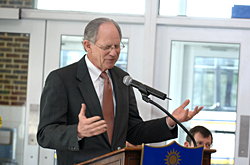
“The University of Delaware has rapidly become a national leader in fuel cell research,” Thomas S. Buchanan, chairperson of the Department of Mechanical Engineering, said.
Under the supervision of Prasad and Advani, researchers at the Fuel Cell Research Laboratory in UD's mechanical engineering department, make their own fuel cells and test them under different conditions in an effort to improve performance and efficiency. In addition, researchers in the chemical engineering department are exploring such questions as whether a less expensive substance could replace platinum as a catalyst in the fuel cell.
Prasad is enthusiastic about the participation of Air Liquide in the project. “Even today I am amazed at our good fortune in having Air Liquide in our consortium,” he said. “They single-handedly solved the problem of refueling our bus.”
Air Liquide, which recently located its research headquarters near Glasgow High School in Newark, has also provided office space to two UD students to foster close collaboration between UD and their research staff.
Prasad said two such refueling stations are located in Washington, D.C., with another planned for New York. A station in Delaware, midway between those cities, would fit with federal plans to create “a hydrogen corridor” of available stations in the Northeast, he said.
Once the bus is in service, the researchers said, it will serve as a public education tool as well as a research subject.
“We want the public to understand that hydrogen fuel technology is a viable and safe power source,” Prasad said. “Seeing a bus in operation will help convince people that this is the wave of the future in terms of clean energy.”
The research team also praised Delaware's Congressional delegation for supporting the project and the request for federal funds.“This project is important, not just for the University but for the whole state,” Faghri said.
Article by Neil Thomas and Martin Mbugua
Photos by Kathy Atkinson



